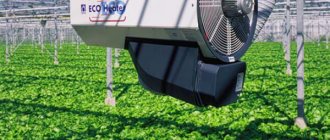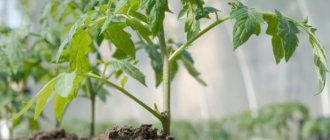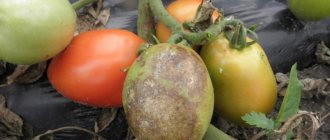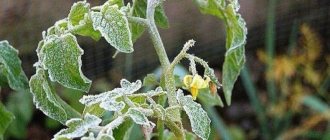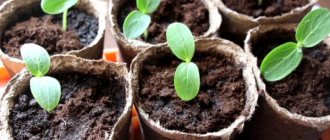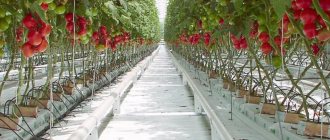The temperature of the air and soil in a greenhouse is very important for growing any crop, and therefore it is necessary to know exactly not only its limits for berries, vegetables or herbs, but also methods for adjusting the “local climate”.
Temperature is one of the decisive factors influencing many processes in plant life : crop growth, absorption of moisture and useful elements, quality and quantity of the crop, time of harvest, the possibility of diseases, etc. Therefore, every summer resident must know the temperature conditions for those crops that are grown on his site in greenhouse conditions, as well as know ways to raise or lower the temperature in the greenhouse when necessary.
First of all, we want to answer questions from readers of our site and tell you what the temperature should be in a greenhouse for cucumbers and tomatoes. This is really important to know.
Temperature for greenhouse tomatoes
The optimal indicators are +20+22°C if the day is bright and sunny, and +19+20°C if the day is cloudy. Night temperature – +16+17°C. This regime is suitable before the fruiting period of tomatoes begins. When it begins, the maximum temperature can reach +26+32°C, but if it is hotter, then even the highest quality flowering will be of little use. Under such conditions, many necessary processes, such as photosynthesis, slow down and pollen grains do not germinate.
During the flowering period, temperatures should not be allowed to drop below +14+16°C, as the tomato will stop blooming.
At a certain period of time, a greenhouse tomato can begin to grow rapidly, and this process must be stopped by stabilizing the temperature at +25+26°C. If you don’t do this, the bush can simply build up a vegetative mass, from which you definitely won’t get the expected harvest.
After the first fruits are removed from the bush, the temperature is lowered to +16+17°C to stabilize the growth of the fruits and their ripening.
Biological heating
An additional and environmentally friendly way of natural heating. Based on the decomposition of organic matter, which releases heat. In addition to heat, carbon dioxide enters the air, which is useful for the ripening of crops. Under suitable conditions, microorganisms heat such biofuel to 60-70 degrees, which is enough for the entire growing season. The process is conventionally called “combustion”.
The traditional material for biofuel is horse manure (according to summer residents, it is the most effective), beef, and pork. You can mix with them fallen leaves, which are harvested in the fall. You can use slightly decomposed peat with the addition of mullein. Straw with a small addition of urea warms well.
Household waste - food from the kitchen, sawdust, paper, rag materials, various non-chemical waste - will wonderfully heat the greenhouse. 30-40% of paper and rags in the fuel is enough for a good reaction.
Biofuels need to be properly stored. Manure is piled up to two meters high and compacted with shovels. After this, they are covered with peat, sawdust, leaves or straw.
Optimal conditions for greenhouse cucumbers
Even before the first shoots appear, containers with crops are kept warm for several days - +25+28°C. When the first greenery breaks through to the surface, the cover is removed, and the crops are installed in a well-lit place where the temperature is kept between +20+22°C. If we talk about night indicators, then in the first 3-5 days after the emergence of cucumber shoots they should be +16+17°C to prevent unnecessary growth of the stem and stretching of seedlings, then they are kept within +19+20°C.
Sudden temperature changes should not be allowed. This, as well as a sharp cold snap in the greenhouse, can lead to disease, depression, plant death, or simply loss of yield.
First category
The optimal operating temperature in such rooms is within 21-28 degrees.
These are facilities where employees perform their job duties in a sitting position and have minor physical exertion. Such premises include watchmaking and clothing production, as well as workshops of automobile and instrument manufacturing enterprises. The intensity of energy consumption of workers producing such products does not exceed 139 W. In the category under consideration, a separate subgroup is distinguished. It includes industries where employees expend more energy (up to 174 W) when performing work. The optimal temperature regimes for such industries are limits starting at 20 degrees. Sources
- https://propolikarbonat.ru/temperatura-pochvy
- https://VyborPrava.com/trud/rabotodatel/temperatura-v-pomeshhenii-po-trudovomu-kodeksu.html
- https://dachadizain.ru/ogorod/optimalnyj-rezhim-temperatur-dlya-rastenij.html
- https://rassada.info/tomatyi/temperatura-dlya-rassadyi.html
- https://www.parnikiteplicy.ru/rasteniya/pri-kakoj-temperature-rastut-ogurcy.html
- https://garden.hozvo.ru/Temperaturadlyarassadyi-20247
- https://shishkin-semena.im/articles/temperatura-dlya-vyrashchivaniya-konopli
- https://fb.ru/article/225576/temperaturnyie-rejimyi-norma-temperaturyi-v-kvartire
Why is climate control necessary in a greenhouse?
It’s simple, because each plant has its own optimal growing temperature, which means that for each crop the optimal “weather” in the greenhouse must be established, taking into account differences, night and day changes. Let us give a simple example that will help explain this position. Let's take open fields with vegetable crops, different crops. And so, in the hot summer, one field has an excellent harvest, but the other has only losses. The whole problem is that the temperature is stable for these fields day and night, that is, different crops receive the same temperature. But, one crop requires indicators of +23+26°C, and they remain stable, while another requires a lower temperature. As a result, there is a harvest in the first field, and in the second, where weather conditions do not correspond to high-quality cultivation, there is no harvest or it is very weak.
So, proper regulation of climatic conditions in a greenhouse building, separately for each crop, leads to the expected result. If the indicators fluctuate on their own, then the structure is of little use, because with a sharp cold snap the plants absorb nutrients much worse; with excessive warming, the plant burns or simply grows.
Constant control of the greenhouse climate gives plants an excellent opportunity to please the owner - to develop the root system and stably absorb nutrients, gain proper growth, form fruit, show timely ripening, and so on.
Vegetable selection
Any crop can be grown in a winter greenhouse, from the popular tomatoes to lettuce and herbs. Among the most popular and productive vegetables:
- cucumbers;
- tomatoes;
- radish;
- head lettuce;
- eggplant;
- Bell pepper;
- various varieties of cabbage;
- zucchini.
It is worth considering that crops have different requirements for humidity and temperature, so they need to be placed in separate greenhouses. For example, tomatoes and sweet peppers require moderate humidity (not higher than 60%) and frequent ventilation. This regime is detrimental to cucumbers, which need a humid and hot atmosphere.
In the cold season, the greenhouse effect with high humidity is easier to maintain.
Therefore, many novice gardeners focus on popular and productive crops that need exactly this regime: cucumbers and radishes.
When choosing varieties, you should give preference to hybrids cultivated specifically for indoor soil. These plants have a short growing season and do not require pollination by insects. Most greenhouse varieties are characterized by good yield and resistance to pests.
Why do you need a temperature sensor?
The sensor will help determine whether you are following the correct regime for growing a particular greenhouse crop, because if you judge different plants, the temperature limits for growing them in a greenhouse can be from +16+25°C during the day, to +12+19°C at night. The soil temperature should almost always be kept at +14+25°C. If there are serious differences, for example, phosphorus starvation, poor absorption of moisture by the root system of plants, wilting, excessive growth of greenery, loss of flowering, and so on may begin.
Therefore, if you are serious about growing greens, vegetables, berries, flowers and other plants, you need a smart system that will help stabilize the temperature in the greenhouse and keep it at the desired level for as long as necessary. Any equipment capable of automatically adjusting the greenhouse climate is suitable for this. Naturally, this pleasure is not cheap, but if you have taken up a serious matter, you must understand the level of costs.
But if your greenhouse is not of an industrial type and there is simply no point in investing serious money in it, you will need to forever remember only a few points:
- What is the optimal temperature in a greenhouse building (made of polycarbonate, glass, etc.);
- How to increase temperature indicators;
- How to lower them.
Thermal characteristics of the soil
Soil temperature is very important for planting, since the supply of moisture and mineral nutrition to the roots, growth and respiration of the plant depend on this indicator. In winter, crops are not planted precisely because soil formation processes cease to occur in frost. In a soil environment heated to a certain level, the movement of water begins again, microbes resume their activity, and so on. The temperature of the soil is influenced by the geographical location of the area and the altitude above sea level, and the properties of the soil itself also matter: its mechanical composition, moisture state, and other properties.
Clay soil in a humid climate in summer will not be as warm as soil with a light texture, but in winter sandy soil will freeze more strongly than more cohesive soils. Moistened soil is colder in summer than dry soil. Due to better air exchange, structured soil will warm up faster in the spring than structureless soil. The temperature of the outer layer of the earth is always higher compared to the root layer.
Ways to regulate the climate in a greenhouse
If automatic regulation of the greenhouse climate is not affordable, you can always get by with simpler methods. It is also important that some of them are much more effective than reasonable technology, especially when it comes to extreme changes in temperature indicators and the speed of this process.
How to raise the temperature in a greenhouse?
- You can arrange additional temporary cover with film, with the help of which you can create a so-called air gap that will practically not react to the environment. Such insulation will allow the crops to retain extra degrees;
- A similar method that will reduce heat loss, as well as stabilize the temperature at the same level. You will need to create a secondary greenhouse inside, above the plants themselves, by installing a cover with wire, fittings, a wooden frame, etc. This way you can create a limited volume of air that will maintain the temperature for a long time. But here it is necessary to remember that the film for the cover must be perforated, the cover must be ventilated in warm weather, and during hot days it must be removed altogether, so as not to increase the temperature to dangerous limits;
- You can mulch the soil to raise the temperature of the soil in the greenhouse. But the mulch should be dense and black in color to attract heat, for example, made of spunbond or plastic film.
Temperature stabilization is very good, but overheating also has an adverse effect on plants, and therefore we recommend constantly monitoring the regime and immediately taking the necessary actions if the indicators begin to rise rapidly.
How to reduce indicators?
- It’s worth starting with some practical advice - do not build very long greenhouses;
- It will be necessary to ensure free access of air through the gables. This way you can bring down about 8-10°C at any time;
- You can spray greenhouses with a chalk solution, to prepare which you will need to dilute 2 kg of chalk in a bucket of water, adding a little milk (300-400 g). After spraying, air temperatures decrease. Do not use only emulsion paints or quicklime, which practically cannot be washed and spoil the film, making it dull;
- Watering crops abundantly in the morning also helps.
Naturally, there are many more ways to increase or decrease the temperature, and they are quite popular and in demand.
Types of regulators
Automatic
There are devices that automatically regulate the temperature readings in the greenhouse
When installing an automatic device, it is important to select the lighting and soil composition. It is also necessary to calculate what hydration should be
For proper development and successful growth of plants, ventilation is necessary. You should think about how greenhouses will be heated at the planning stage.
In the age of innovative technologies, the hassle of providing heat fades into the background. Thermostats are excellent at maintaining temperature without human intervention. Now you no longer need to think about shading curtains, install fans and heaters.
An automatic heat regulator will provide the required temperature in your summer cottage for a week without your presence, and will consume little electricity. Today, precise temperature conditions can be maintained using electronic thermostats for greenhouses. They instantly respond to the slightest changes in the system.
Sensory thermoregulation in the greenhouse allows you to set a certain temperature at different times and set the exact operating time. The principle of operation of a simple thermostat occurs according to the following scheme: the device processes the readings of sensors that regulate the operation and gives a signal to the heating system. As a result, the system operates for heating or cooling.
Mechanical
A mechanical thermostat is a device whose main task is to regulate the operation of equipment to maintain a certain temperature. It can be used in both heating and cooling mode. This heat regulator is a self-sufficient device that is mounted in a greenhouse.
Temperature conditions in the greenhouse (20 photos)
Frost protection
Evening watering of the soil is an effective way to protect against frost down to -5-6 degrees. There is no need to pour in a lot of water; a medium static spill from a hose or watering can will suffice.
Smoke – several piles of garbage, rotten firewood and sawdust are piled up on the leeward side. A peg is stuck into the middle of the future fire. At night, such piles are set on fire and with their smoke screen they will protect your garden from frost down to -4 degrees. Unfortunately, in strong winds this method is ineffective.
Plastic opaque bottles are filled with hot water and evenly laid out inside the desired room. It is advisable to dig them a little into the ground.
As we can see, the process of retaining heat turned out to be not such a difficult task. For the most part, a positive effect can be achieved using improvised means and household materials, showing cunning and ingenuity. And at the end of the season, your greenhouses and greenhouses will become real islands of abundance!

